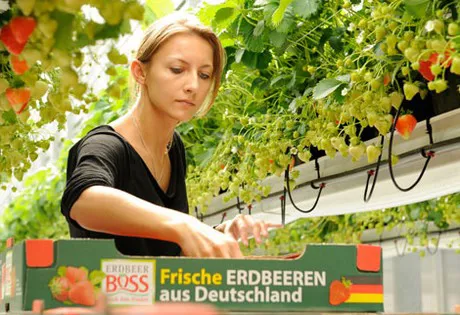Domestic strawberries from mid-April and into October; this can only be thanks to modern cultivation methods in film tunnels. Until about 15 years ago, the season for strawberries was relatively short. The weather had to cooperate, so that the fruits in the fields would be ripe in the spring. Foil covers helped to speed up the process a bit. If it was too warm and sunny, the harvest was over. Therefore, at the beginning of the 1990s, German farmers began to build dams where they planted the plants and subsequently roofed them with traveling tunnels. But still the planted areas had to be changed regularly. This is because strawberries thrive best on fresh soil. For example, soil where potatoes or vegetables were grown the year before.

Not in the soil anymore
Such fields are not available to every strawberry grower. Therefore, more and more of them rely on vertical cultivation. The strawberries no longer grow in the soil, but above the floor in substrate-filled boxes, which are attached to metal structures. Fertilization takes place through automatic irrigation. This has a number of advantages: picking becomes more comfortable, easier on the back and more effective. A surface can be used for years with consistently high berry quality. And fertilizing and watering is only as environmentally friendly as the plants need. In addition, the ripeness of the fruits can be better controlled. Less and less is left to chance or the whims of Mother Nature.
Protection against the vagaries of nature
About 20% of German strawberries are already grown through protected cultivation. Experts estimate that this proportion will be 50% within ten years. The permanently installed tunnels are becoming increasingly similar to the greenhouses in their technical equipment and can be equipped, for example, with automatic ventilation.
There is another big bonus of this modern strawberry culture: It reduces leaf and fruit diseases. Furthermore, pests can be controlled more easily with biological opponents, so-called 'beneficials'. This can greatly reduce the use of pesticides. Plant protection measures are only carried out if there is a clear diagnosis. Plant protection consultants act like doctors - and only prescribe 'medicine' when it is needed.
Supporting regional cultivation
However, investing in the scaffolds and film tunnels also means that fruit growers have to be able to sell their fruits at stable prices for years, until they have recovered the production costs. Buying from a local strawberry producer not only guarantees fresh, ripe fruits with an excellent taste, but also helps support regional cultivation under sustainable conditions.
Even berry bushes thrive better in the film tunnel
In Germany, not only strawberries, but berry bushes as well are grown increasingly in tunnels. Blueberries can be harvested about three weeks earlier and the end of the season is pushed back. With raspberries, the protection of the fruit and thus their durability are in the foreground, as well as more reliable harvest timing. According to official figures, there are already 250 hectares of covered raspberry cultivation in Germany, and around 50 hectares of blackberries - and the trend is rising. The first German blackcurrants, cultivated under film, are already on the market.
Source: Gabot.de
